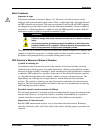
Appendices
200 UDA2182 Universal Dual Analyzer Product Manual January 2009
15.2 Appendix A – Entering Values for Lead Resistance Compensation
(See Appendix B for titanium cells mounted into stainless steel flow chamber 31079198)
Introduction
If you use standard Honeywell cell lead lengths of 7 or 20 feet connected directly to the
Analyzer, no compensation for lead resistance is necessary. Similarly, if a junction box
is used to extend the leads up to 150 feet, no compensation is required. However, if
longer leads are used (greater than 150 feet), signal accuracy can be adversely affected
unless you enter information that will permit the UDA2182 to compensate for lead
resistance in the black and white cell leads only. Lead resistance compensation is not
necessary, nor applied to the other cell leads.
For lengths up to 1000 feet*, simply specify the gauge and length as described in Table
6-5. Note that the maximum wire size for sensor inputs at the input terminal board is
16AWG.
*
DirectLine DL4000 series cells have a total lead length limit of 250 feet.
If mixed wired gauges are used, or lead length or wire gauge are not within the stated
ranges, the UDA2182 can still perform the compensation. However, you must first
calculate the lead resistance, and then put it in terms of the available settings for AWG
gauge and length.
The resistance of each available gauge choice (in copper wire) is:
16 AWG = 4.0 ohms per 1000 feet
18 AWG = 6.4 ohms per 1000 feet
20 AWG = 10.2 ohms per 1000 feet
22 AWG = 16.1 ohms per 1000 feet
For example, suppose extension cables between the cell and Analyzer consist of 500 feet
of 18-gauge wire and 200 feet of 16-gauge WIRE. The cell has the TC head option.
500 ft of 18 AWG wire 200 ft. of 16 AWG wire
Analyzer
Honeywell
Junction Conductivity Cell
Box
Figure 15-1 Example of a Conductivity Loop
Because there are two different types of wire used in each lead to the cell in this example,
the total lead resistance is calculated as follows: (Note: the analyzer accounts for the fact
that there is always a pair of conductor wires in the system loop.)
(0.5 x 6.4) + (0.2 x 4.0) = 4.0 ohms


















